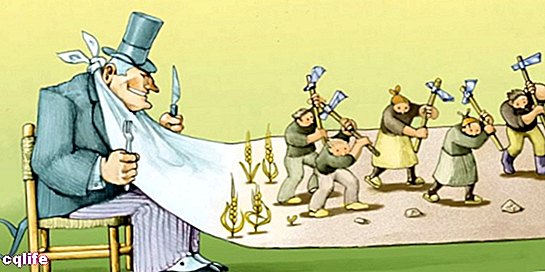We explain what satire is, its origin, characteristics and examples of great satirical authors. Also, what is political satire.

What is satire?
Satire is a literary genre and at the same time an expressive resource, through which the author expresses his indignation or his opposition to something, through humorous procedures, that is, mockery, irony or caricaturing. Satire does not aspire to humor in itself, or to pure amusement, but to express the author's disapproval, either veiled or openly, generally for moralizing or critical purposes.
The origins of satire go back to the greek antiquity, especially to the poetry Iambica of Semónides of Amorgos (7th-6th centuries BC) and Archilochus of Paros (712-664 BC), and the work of playwrights such as Aristophanes (444-385 BC), whose legacy was inherited from Roman humorists such as Gaius Lucilio (148-102 BC) and Luciano de Samósata (125-181).
In fact, it was so widely cultivated in ancient Rome that Marcus Fabius Quintilian (c. 35-c.95) christened it “a completely Roman genus” (“saturates quidem tota nostra est”).
Back then satire could take different forms, such as dialogues, songs, epigrams, etc., both in verse like in prose, or alternating both registers. However, it would not be exclusive to the literature: illustration, cinema and even music they make use of it very frequently.
Characteristics of satire
Broadly speaking, satire is characterized by the following:
- It is a form of representation of real references, ideas, people or even other artistic or philosophical works.
- It has a mocking, ridiculing or critical intention, which is expressed through parody, comparison of dissimilar referents, exaggeration and / or double meanings.
- It is expressed in an immense variety of themes, tones and methods, but in general they always have a critical or moralizing purpose, that is, pedagogical or denouncing.
Examples of satirical authors
Throughout the history There have been hundreds of authors of satirical work, especially since this genre allowed them to mock each other and to literally settle their enmities. There were, however, great Roman satirical authors, who are usually considered the formal creators of the genre, such as:
- Gaius Lucilio (147-102 BC), whose work has been lost with the passage of time, but is often referred to by other Roman satirical poets.
- Marco Terencio Varrón (116-27 BC), author of Menippean satires, in which verse and prose were mixed.
- Quinto Horacio Flaco (65-8 BC), whose satirical work consisted mainly of sermons and dialogues, in which sentences and criticisms were introduced in a less virulent way.
- Lucius Anneo Seneca (4 BC - AD 65), called Seneca the Younger to differentiate him from his father, whose prose work abounds in philosophy moral and satirical references.
Other great and recognized cultists of satire were, from the Middle Ages henceforth, the Spaniards, not only in their lyrics and poetry, but particularly in their plays of Golden age and his first novels modern. Some important names in this tradition were:
- Juan Ruiz, Arcipreste de Hita (c. 1283-1350), whose work is considered among the most important of the Medieval literature Spanish, was the first to properly use satire to criticize the influence of the money that was already beginning to upset the feudal society of the time.
- Alfonso Martínez de Toledo, Archpriest of Talavera (1398-c.1468), pre-Renaissance author whose greatest work is a satire of worldly love and lust, The Corbacho, from 1438.
- Miguel de Cervantes (1547-1616), the greatest author of the Spanish tradition, is famous precisely for a satire of chivalric novels: The Ingenious Gentleman Don Quijote of La Mancha of 1605. However, it was not his only satirical text: he is also known The Colloquium of the dogs from 1613 and Parnassus trip from 1614.
- Lope de Vega (1562-1635), one of the great exponents of the dramaturgy Spanish of the Golden Age, was lavish in satires against Luis de Góngora, his rival, as well as against the tradition of Culteranismo.
- Ramón de Valle-Inclán (1866-1936), poet modernist and founder of a novelistic style called "the absurdity", characterized by grotesquely deforming the reality and accentuate his comic and vulgar features, attacking everything that was considered consecrated or correct.
Political satire

One of the favorite scenes of the appearance of satire is that of the politics. In part this is because making fun of the powerful allows the people to express their disagreements and channel their discontent in a peaceful and democratic way, but also because it constitutes an exercise of arrogance, of symbolic violence against people who are, commonly, untouchable.
Political satire thus descends from the powerful to the level of the common people, and at times fuels the already lit fire of subversion and revolution, echoing the sentiment of the masses. All political satire obeys the ideology or preferences of the cartoonist or writer, so that there is no "impartial" or "apolitical" or "neutral" satire. At the same time, political satire can be written, drawn, filmed, and so on.
A good example of this is the film The great Dictator by Charles Chaplin (1889-1977), released in 1940, in which the comedian makes fun of Adolf Hitler and the fascism European.
